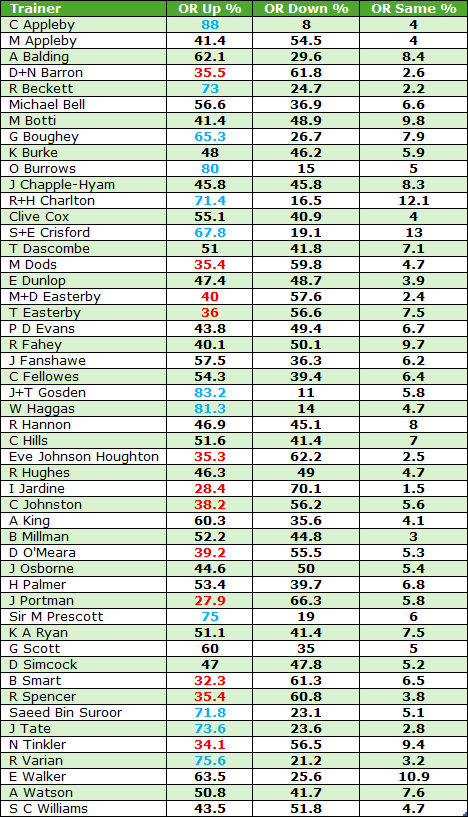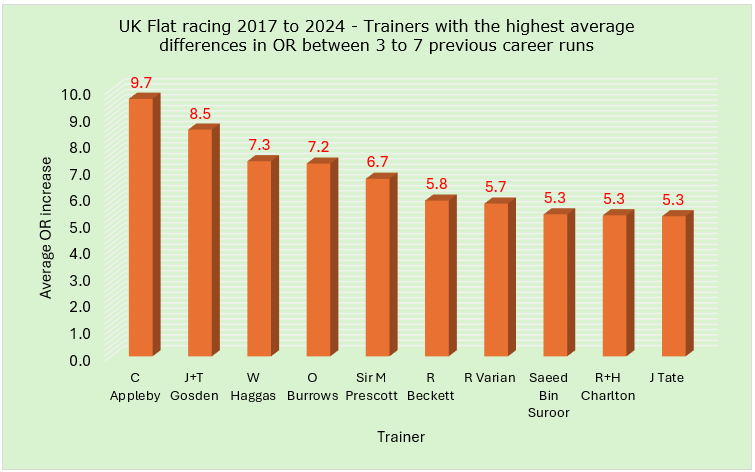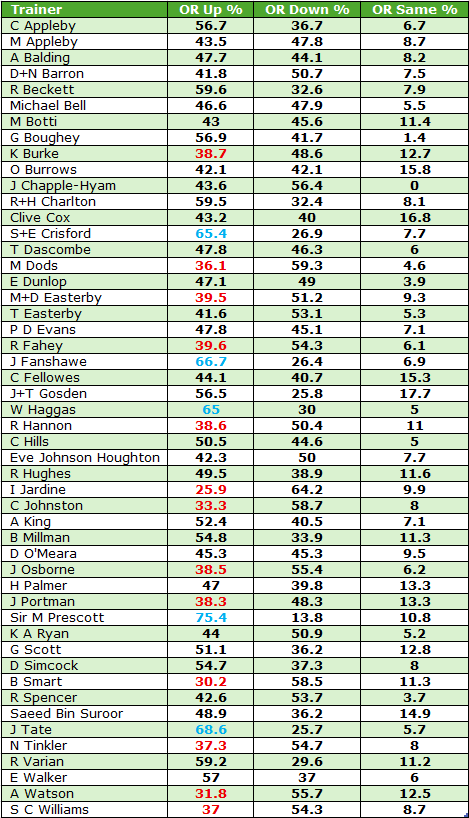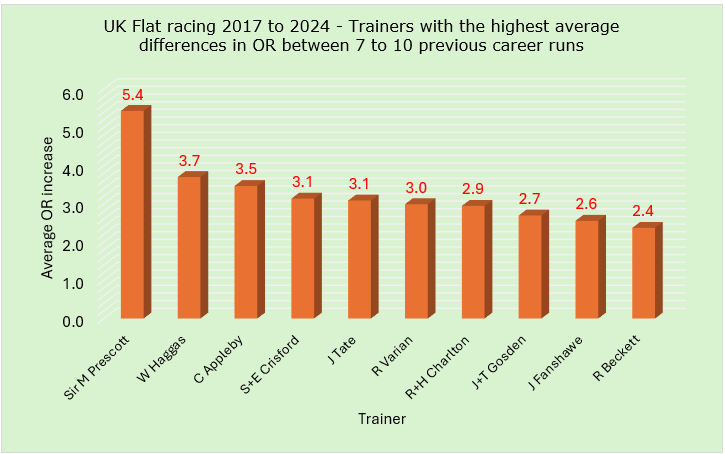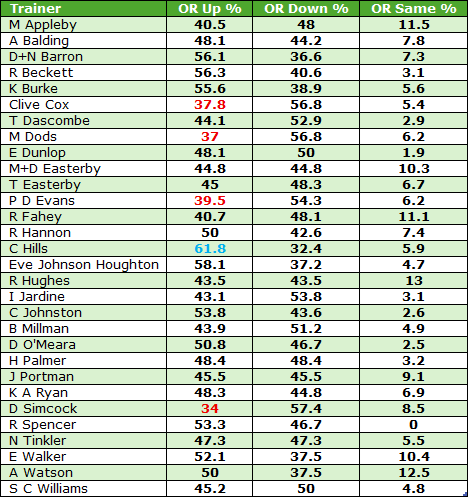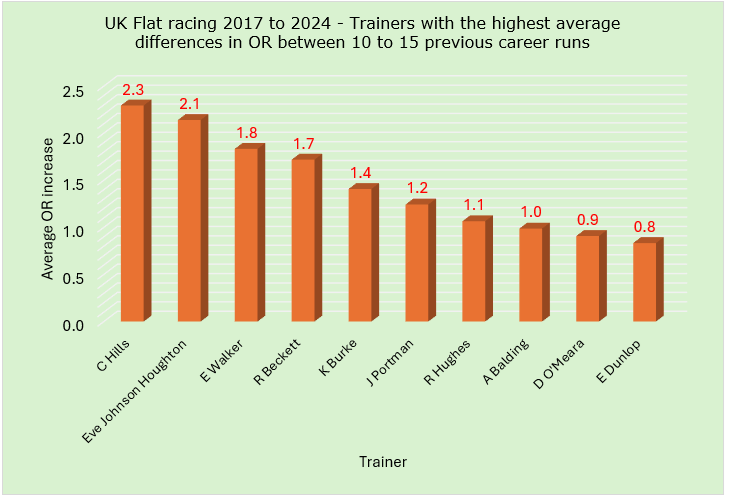Using Official Ratings to Measure Trainers’ Ability
Using Official Ratings to measure trainers' ability
Trying to predict whether horses are improving, have reached their ceiling, or are on the downgrade is a part of the racing puzzle that punters have get a handle on, writes Dave Renham. Whether it equates to long term profits is still determined by how much value we are getting, especially on winning selections. If we spot an improver but everyone else does too, it is unlikely to offer value because the price will be driven down by popular opinion. However, if we can spot an improver that most of the crowd do not, then that is a different matter.
Introduction
In this article I will look at fifty trainers with the aim of trying to gauge whether their horses improve, or not, within specific time frames. To do this, I compared their horses in terms of movement in Official Ratings (OR). Specifically, I compared their ORs after three, seven, ten and fifteen career starts.
For each trainer I will first compare horses' OR figure between three and seven starts, then seven and ten starts, and finally ten and fifteen. I have taken data from 2017 to 2024 and, when quoting any profit/loss figures, I have calculated to Betfair Starting Price (BSP) less 2% commission.
It's important to note that only UK and Irish runs are included, so those horses that have raced overseas may have had more than the stated number of runs. Overall, this difference should be negligible but feel free to consider some of the stats approximations and use the intel accordingly.
Three career runs vs. seven career runs
This first group is dominated by younger horses: around 22% of them were aged two and roughly 64% were aged three. I have calculated the percentage of horses within each stable that saw an improved Official Rating between their third and seventh career runs, those with a decreased rating, and those that stayed the same. The trainers are listed in alphabetical order, with any positives and negatives highlighted in the ‘OR Up %’ column. Positive percentages in blue (65% and above); negative percentages in red (40% and below).
It should come as no surprise to see Charlie Appleby, William Haggas, Sir Mark Prescott, Roger Varian, and the Gosden and Charlton stables with a high percentage of horses who have improved their ORs within this early time frame. Many of the lower scoring trainers are more renowned for handicappers and hence it will be interesting to see whether their figures start to improve as the number of runs increases.
Charlie Appleby’s figures are quite stunning with 88% of his horses increasing their OR figure between career runs three and seven. Digging deeper, backing all Appleby runners that had previously run between three and seven times would have seen the following impressive figures: 245 wins from 956 runners (SR 25.6%) for a profit of £189.87 (ROI +19.9%); A/E 1.08.
Here are some further Appleby stats to keep an eye out for this coming autumn. His horses that had run exactly three times and were racing for the fourth time in either September or October produced 30 wins from 74 runners (SR 40.5%) for a profit of £42.67 (ROI +57.7%); A/E 1.34. Add one run to that - those horses who had four career starts and were having their fifth in September/October - and their record reads 13 wins from 41 (SR 31.7%); A/E 1.26 for a profit of £18.40 (ROI +44.9%); A/E 1.26.
Next, I have calculated the average OR improvement per horse that the ‘better’ trainers achieved within these past runs grouping. [By ‘better’, I mean those with the top ten percentage improvement figures].
Charlie Appleby again tops the list. On average his horses improved 9.7lbs between those four runs from third to seventh career start, a very decent figure. All trainers in this top ten have performed well above the norm.
Seven career runs vs. ten career runs
Onto the second grouping. Logic dictates that the improvement achieved later in horses' careers will be less in OR terms overall than with the previous group of runners. This is indeed the case and hence I have moved the positive percentage figure to 60%+ (in blue); the negative figure remains at 40% or lower:
Sir Mark Prescott heads the figures here, with 75% of his runners improving their ORs between their seventh and tenth career start. Backing all Sir Mark's runners that had raced between seven and ten times previously across these eight years was worth 100 wins from 388 (SR 25.8%) for a profit of £44.73 (ROI +11.5%).
Next in the list are James Tate (68.6%), James Fanshawe (66.7%), Simon & Ed Crisford (65.4%) and William Haggas (65.0%). Prescott, Tate, Crisford and Haggas all had positive ‘blue’ figures in the first table as well.
At the other end of the scale, there are some surprisingly low improvement percentages for Charlie Johnston (33.3%) and Archie Watson (31.8%).
Let me once again calculate the average OR improvement per horse that the top ten trainers achieved within the 7-10 grouping:
Sir Mark Prescott is comfortably ahead, averaging an improvement per horse of 5.4lb. For the record, 38 of the 50 trainers managed a positive percentage improvement across their total runner cohorts. The numbers for these top ten are lower overall than we saw for the first grouping, but as horses get more exposed it is harder for them to improve their OR figure.
The horse that showed the biggest improvement was Love So Deep trained by Jane Chapple-Hyam. Her rating went up 27lbs from 74 to 101.
Ten career runs vs. fifteen career runs
Finally, a look at this most exposed of the three groupings. This time there are several trainers who have not saddled enough runners to make the figures meaningful. I have included trainers who had at least 30 qualifiers - 20 of the original list missed out on that basis. Here are the splits for the remaining 30 trainers with the same colour coding as for the previous group:
Charlie Hills is the only trainer to have improved more than 60% of his horses in terms of their OR figure between their tenth and 15th starts. Meanwhile, Messrs. Cox, Dods, Evans and Simcock all ended up below the 40% mark in terms of improvement. These are four trainers that I had expected to have much better figures.
Of the trainers that didn’t make the list due to limited qualifiers, I should mention that the Charlton stable saw improved ORs for 13 of their 15 qualifiers (86.7%). Also, George Boughey saw 20 of his 26 (76.9%) achieve improved ORs.
The final graph shows the average OR improvement per horse that the top ten trainers in this group achieved within the 10-15 career run bracket. Naturally, these are much lower than we have seen previously:
The horse that improved the most within this whole grouping was Lion Hearted, trained by Mick Appleby. He improved 28lbs from a rating of 58 after 10 starts to a rating of 86 after 15 starts.
*
As horses mature there is usually less improvement to be had before they settle at their ability level; however, as we've seen, some trainers find that level quicker than others, and knowing which to follow now and which to be patient with is a big advantage on Joe Punter.
Good luck
- DR

